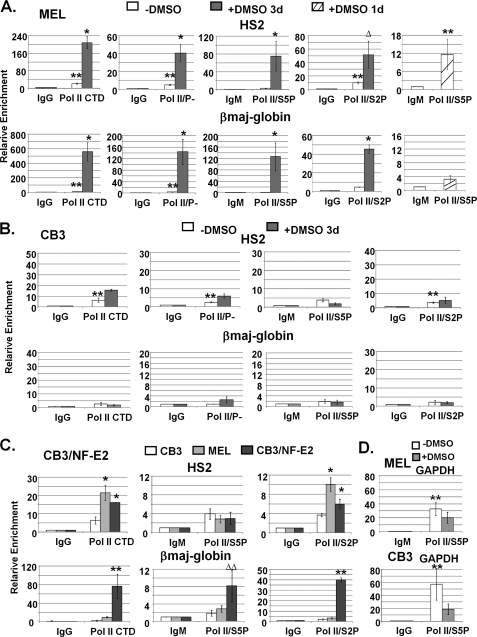FIGURE 3.
Efficient recruitment and phosphorylation of Pol II at the β-globin gene locus requires NF-E2 (p45). A, ChIP analysis of Pol II interactions in the β-globin gene locus in MEL cells incubated with or without 1.5% DMSO for 1 or 3 days. Chromatin was isolated from cross-linked MEL cells, fragmented by sonication, and immunoprecipitated with antibodies specific for the Pol II CTD (Pol II/CTD), for unphosphorylated Pol II (Pol II/P−), or for Pol II phosphorylated at serine 5 (Pol II/S5P) or serine 2 (Pol II/S2P) of the CTD. IgG or IgM antibodies were used in these experiments as negative controls. DNA was isolated from the precipitates and subjected to qPCR with DNA primers specific for LCR HS2 or the adult βmaj-globin gene promoter as indicated. Error bars, S.E. from three independent experiments (**, sample versus IgG, p < 0.05; *, DMSO versus no DMSO, p < 0.05; Δ, DMSO versus no DMSO, 0.05 < p < 0.1). B, ChIP analysis of Pol II interactions in the β-globin gene locus in CB3 cells incubated with or without 1.5% DMSO for 3 days. Chromatin precipitation and DNA analysis by qPCR was performed as described in A. Error bars, S.E. from three independent experiments (**, as described in A). C, comparative ChIP analysis of Pol II interactions in uninduced CB3, MEL, and CB3/NF-E2 cells. Chromatin precipitation and DNA analysis by qPCR were performed as described in A. Error bars, S.E. from three independent experiments (*, CB3/NF-E2 versus CB3, p < 0.05; **, CB3/NF-E2 versus CB3 and MEL, p < 0.05; ΔΔ, CB3/NF-E2 versus CB3 and MEL, 0.05 < p < 0.1). D, ChIP analysis of Ser-5-phosphorylated Pol II at the GAPDH promoter in undifferentiated and DMSO-induced MEL and CB3 cells (as indicated). Cells were grown in the absence or presence of DMSO (1.5% for 3 days). DNA was isolated from immunoprecipitated material and analyzed by qPCR as described in A. Error bars, S.E. from three independent experiments (**, as described in A).

